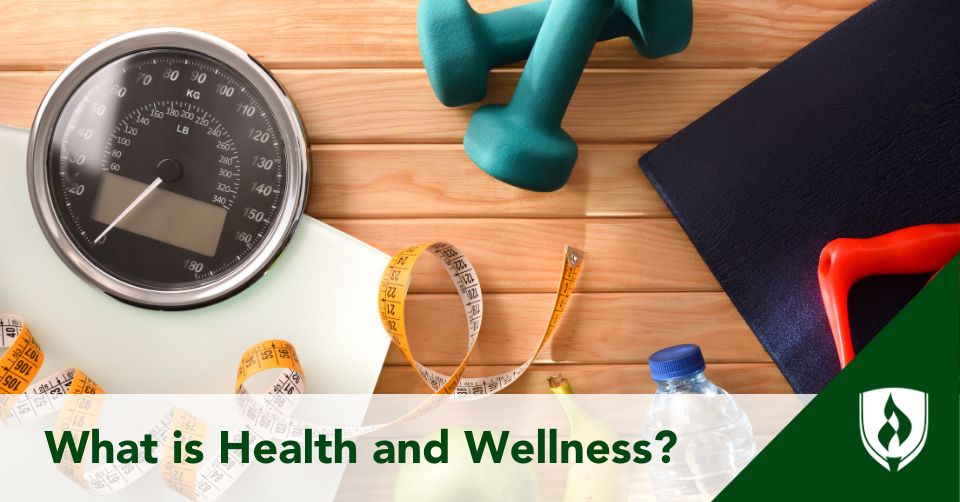What Is Health and Wellness?
08/12/2025

If you’re someone who wants to make a difference in the lives of others, chances are you’ve thought about a career that helps people feel better, live longer, and thrive in their day-to-day lives. What does that actually look like and how do you study something so broad? You might start by asking: What is health and wellness?
For many students, the term brings to mind things like fitness, nutrition, or hospitals. While those are all part of the big picture, the field of health and wellness goes much deeper. It focuses on how individuals and communities can improve their well-being, prevent illness, and build healthier lifestyles, physically, mentally, socially, and even environmentally.
Health Is More Than Just the Absence of Illness
The definition of health has evolved over time. While many people think of health as simply “not being sick,” the World Health Organization defines1 it as “a state of complete physical, mental, and social well-being, not just the absence of disease.” That distinction matters, especially for students thinking about careers that go beyond clinical care.
Health is multidimensional and typically includes:
- Physical health: Physical activity2 is any movement that uses energy, including work, exercise, and daily tasks. Involves regular exercise, balanced nutrition, proper sleep, and the ability to prevent or manage illness. Students interested in exercise science, fitness, or sports health often begin here.
- Mental and emotional health: Mental and emotional health3 focuses on emotional regulation, psychological resilience, and the ability to manage stress. This area is becoming increasingly important across education, workplace health, and public wellness programs.
- Social health: Social health4 relates to strong interpersonal relationships, communication skills, and a sense of belonging. People with strong social connections often have better overall health outcomes and quality of life.
These dimensions are interconnected, and understanding them forms the foundation for many academic programs in health education, health services, and community health initiatives.
What Wellness Means, and Why It’s Different
While health refers to a state of being, wellness is more of a process.5 Wellness is the ongoing, intentional pursuit of a balanced and fulfilling life. It’s about making daily choices, big and small, that promote long-term well-being.
Wellness is also multidimensional. Key areas of wellness include:6
- Emotional wellness: Involves taking care of your mental and emotional needs, practicing self-awareness, and developing healthy coping mechanisms. It’s also about seeking help when needed and maintaining balance through stress management techniques.
- Occupational wellness: Focuses on finding purpose, satisfaction, and growth in your career or role. This is especially important for corporate wellness professionals and those designing programs that enhance employee morale.
- Spiritual wellness: Encourages reflection on personal values, beliefs, and life purpose. While it may involve religious faith for some, it can also mean seeking meaning and alignment in everyday actions.
- Environmental wellness: Look at how physical surroundings, such as air quality, safety, and access to nature, affect your health. Clean, supportive environments are essential to achieving and maintaining healthy living.
Together, these dimensions help shape how individuals and communities thrive. In wellness-focused degree programs, students often explore these topics through both theory and applied learning, developing the skills needed to support others in achieving long-term health and wellness goals.
The Connection Between Health and Wellness
Though health and wellness are distinct, they are deeply interconnected.7 Improving one often supports the other. For example, when someone takes steps to reduce stress through movement, mindfulness, or connection with others they may experience better sleep, stronger immunity, and improved focus. On the flip side, physical illness can impact emotional health, social interaction, and even job satisfaction.
That’s why professionals in this field often take a holistic approach.8 If they’re working one-on-one with clients, developing a wellness program for a business, or conducting outreach in underserved neighborhoods, the goal is to address the whole person, not just a symptom or diagnosis.
Why This Field Matters More Than Ever
Health and wellness are no longer fringe interests or personal hobbies, they are essential elements of a thriving society. As communities struggle with rising rates of chronic diseases, mental health challenges, and environmental threats, the demand for professionals who can promote health and prevent illness is growing rapidly. According to the CDC,9 nearly 1 in 5 U.S. adults experience a mental illness each year, yet many lack access to necessary care.
Organizations across sectors from corporate, nonprofit, healthcare, and education are investing in health education and prevention initiatives. The Global Wellness Institute reports10 a global wellness economy valued at $6.3 trillion in 2023, projected to reach $9 trillion by 2028, reflecting rising investments in well-being and prevention.
Workplace wellness programs have been associated with improved employee well-being and organizational efficiency. CDC assessments indicate11 that employers can receive $3-15 in savings for every $1 spent, due to lower healthcare claims, reduced absenteeism, and improved productivity. These measurable benefits have driven widespread adoption of wellness programs in hospitals, schools, corporate offices, and public health departments.
What You Might Learn in This Field
If you're interested in this path, your college experience might include courses like:
- Introduction to Healthcare Administration
- Quality Improvement in Healthcare
- Contemporary Health and Wellness
- Multidisciplinary Medical Practices
- Healthcare and Aging
- Behavioral Health
- Epidemiology
Rasmussen University's bachelor's in health and wellness program offers12 these and other courses to help prepare students for a wide range of health and wellness careers.
Is Health and Wellness the Right Fit for You?
This field attracts people who are passionate about helping others, who enjoy both science and service, and who want a career that blends communication, empathy, and action. If you're interested in programs that challenge you to think critically and make real-world impact, a path in health and wellness may be worth exploring.
You don’t need to know right now whether you’ll be a coach, educator, administrator, or advocate. What matters most at this stage is curiosity and a desire to contribute to something meaningful. As you learn more about degree options and career tracks, you’ll begin to shape a path that aligns with your values, strengths, and vision for the future.
Where Will Health and Wellness Take You?
Health and wellness are about more than just personal habits. They shape the systems, communities, and relationships that define our everyday lives. And they offer students like you the chance to turn empathy into action, and knowledge into lasting change.
Whether you see yourself working in schools, businesses, clinics, or beyond, this is a field that can offer opportunities to support others and engage in ongoing learning. If you're ready to explore a future where you may support others in their pursuit of healthier lives, now is a great time to take the first step.
1World Health Organization, Constitution of the World Health Organization, available at https://www.who.int/about/governance/constitution (accessed July 3, 2025).
2Centers for Disease Control and Prevention, About Physical Activity, available at https://www.cdc.gov/physical-activity-basics/about/index.html (accessed July 3, 2025).
3 World Health Organization, Mental Health: Strengthening Our Response, available at https://www.who.int/news-room/fact-sheets/detail/mental-health-strengthening-our-response (accessed July 3, 2025).
4Centers for Disease Control and Prevention, Why Is Addressing Social Determinants of Health Important?, available at https://www.cdc.gov/about/priorities/why-is-addressing-sdoh-important.html (accessed July 3, 2025).
5Debbie L. Stoewen, “Dimensions of wellness: Change your habits, change your life,” The Canadian Veterinary Journal, vol. 58, no. 8, 2017, pp. 861–862, available at https://pmc.ncbi.nlm.nih.gov/articles/PMC5508938/ (accessed July 3, 2025).
6Substance Abuse and Mental Health Services Administration, SAMHSA’s Concept of Trauma and Guidance for a Trauma-Informed Approach, available a thttps://library.samhsa.gov/sites/default/files/sma16-4958.pdf (accessed July 3, 2025).
7Helene M. Langevin, “Health and Well-Being: Distinct and Intertwined Concepts,” Medical Care, vol. 62, 12 Suppl 1, 2024, pp. S13–S14, available at https://pmc.ncbi.nlm.nih.gov/articles/PMC11548804/, (accessed July 3, 2025).
8 Beverley Argus-Calvo et al., “A holistic approach to sustain and support lifelong practices of wellness among healthcare professionals: generating preliminary solid steps towards a culture of wellness,” BMC Medical Education, vol. 24, no. 1, 1364, Nov. 26, 2024, available at https://pmc.ncbi.nlm.nih.gov/articles/PMC11590568/, (accessed July 3, 2025).
9Substance Abuse and Mental Health Services Administration, What Is Mental Health?, available at https://www.samhsa.gov/mental-health/what-is-mental-health/facts (accessed July 3, 2025).
10Global Wellness Institute, The Global Wellness Economy, available at https://globalwellnessinstitute.org/industry-research/the-global-wellness-economy/ (accessed July 3, 2025).
11Centers for Disease Control and Prevention, Evidence of Impact for Workplace Health Promotion, available at https://hdsbpc.cdc.gov/s/article/Evidence-of-Impact-for-Workplace-Health-Promotion (accessed July 3, 2025).
12Rasmussen University, Health and Wellness Degree Overview, available at https://www.rasmussen.edu/degrees/health-sciences/health-wellness/ (accessed July 3, 2025).



